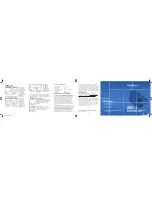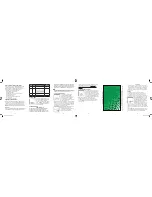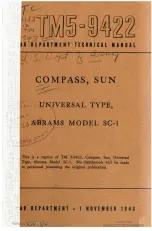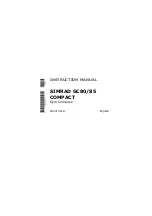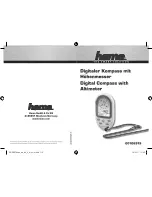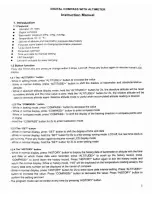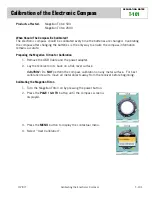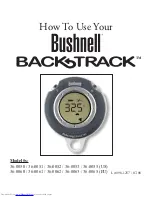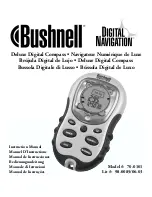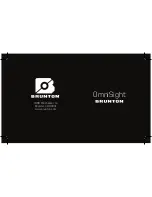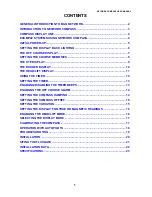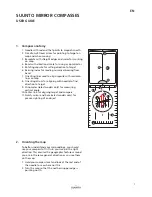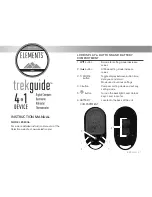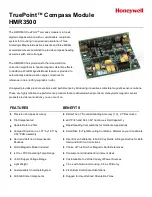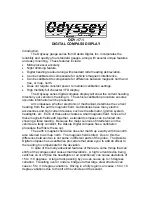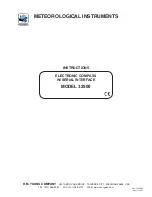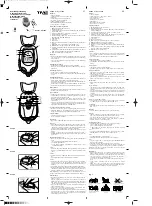
2
3
4
5
6
7
DCC-1 Digital Compass/Clinometer
The DCC-1 is the smallest, lightest and most accurate
instrument for measuring of horizontal and vertical
Angles. The DCC-1 is small enough to fi t in your pocket,
and packed with the latest digital technology.
•
Extremely low power consumption
•
Rugged ABS plastic housing
•
Durable and reliable
•
Lightweight - only 1 oz. (1.5 oz. w/batteries)
•
Single-handed operation
•
Adjustable declination
•
Built-in ±10° horizontal compensation
•
Backlit display
•
Easy one-button operation.
Sighting Using The DCC-1
Hold the DCC-1 with the button facing upward for all
readings. Both eyes should be used and kept open when
sighting, using the right eye to read the display, and
the left to sight the target. While this method may feel
awkward in the beginning, it becomes comfortable with
practice.
Functions
Choose operating functions by pressing the button the
required number of times according to the chart:
Press
Button Display
Operation
Menu/
Function
1X
Cº
Compass (0 - 359°)
Compass
Mode
2X
Ang
Angle Measuring (-90.0 -
+90.0)
Note:
You can also enter Angle
mode directly from Compass
mode by pressing and holding
the button for 2 seconds
Angle Mode
3X
SEt
Settings (Declination
Adjustment)
Settings
4X
CAL
Calibration (Compass)
Calibration
Battery (BAt)
The DCC-1 instrument uses one (1)
standard 1.5V AA battery. A battery
test is performed each time the
instrument is activated. If the battery
is low, the
BAt
message appears for a
moment, indicating that the battery
should be replaced.
Calibration (CAL)
±
IMPORTANT!
±
All compasses use and are affected by the Earth’s
magnetic fi elds and are sensitive to magnetic
disturbances and deviations that can be caused by
a number of sources, such as the presence of heavy
metals, household appliances, computers, high voltage
power lines, etc. Even metal framed glasses can cause
disturbances in the compass function. If you wear metal
framed glasses, calibrate the DCC 1 with your glasses
on.
The DCC-1 must be calibrated before it is used, and after
each time the battery is removed or replaced. Compass
calibration is performed using the
CAL
function.
Compass Calibration (CAL)
Press the button four (4) times to
activate the Calibration (
CAL
)
function. During the following 10-20
seconds, the instrument should be
rotated at least one or two times,
preferably on a fl at surface free from
magnetic disturbances.
Alternatively, you can hold and aim the instrument while
turning 360° one or two times. This method is preferred
if the operator is wearing metal framed glasses. Maintain
a steady, horizontal position while calibrating to ensure
the compass will display correct values.
While calibrating, the instrument will
display the elapsed time since
initiating the calibration operation, up
to a maximum of 60 seconds.
Exit the Calibration function by
pressing the button once. The unit will beep to confi rm
that the
CAL
function has closed. Always test the
compass function in at least four (4) directions after
calibration!
Declination Adjustment (SEt)
Declination is the difference between
true (geographic) north and magnetic
north. The DCC-1 will automatically
adjust the measured compass bearing
for the correct magnetic declination of
your position using the
SEt
function. If
no magnetic declination adjustment is
made, the compass will read magnetic north.
To adjust for true north, you must fi rst know the
declination for your local area (see map on next page).
Use the
SEt
function to enter the declination of your
current position.
19
18
17
16
15
14
13
12
11
10
9
8
7
6
5
4
3
2
1
-1
-2
-3
-4
-5
-6
-7
-8
-9
-10
-1
1
-12
-13
-14
-15
-16
-17
-18
-19
-20
-21
0
20
20
21
19
18
17
16
15
14
13
12
11
10
8
7
6
5
4
3
2
-2
1
-1
-4 -3
-6 -5
-8 -7
-10
-12
-9
-1
1
-14 -13
-16
-17
-18
-19
-20
-15
0
9
Un
ite
d
St
at
es
M
ag
ne
tic
D
ec
lin
at
on
M
ap
b
y
Th
e
Na
tio
na
l A
tla
s
of
th
e
Un
ited
St
at
es
Un
ited
St
at
es
D
ep
ar
tm
en
t o
f t
he
In
ter
io
r
ht
tp
://
na
tio
na
la
tla
s.
go
v/
in
de
x.
ht
m
l
±
NOTE!
±
Declination changes over time, even at the same location. To
correctly compensate for magnetic changes, it is important to
consider your position when measuring. A Declination Map
can be used as a guide, or there are a number of calculators
available on the internet to determine the correct declination
for your location.
Example
The magnetic declination for Seattle is 19°. Without
compensating for this deviation, the compass will show
0° to magnetic north. Since the decination is 19° to true
(geographical) north, this value (19°) should be entered in the
Settings menu (SEt). The compass will display the correct 19°.
Activate the
SEt
function by pressing
the button three (3) times. Enter the
declination by holding the button
down and tilting the instrument up or
down until the correct value is
displayed. Release the button when
the correct value is displayed. If the
Angle is insuffi cient to obtain the correct desired value,
simply release the button and start over. By repeating the
operation, any declination between -45º and +45º can be
set.
Exit the
SEt
function by pressing the button once. The
DCC-1 will maintain the declination values from the last
input, even after changing or removing the battery.
7168_Instructions-c.indd 2
8/12/09 9:56 AM

